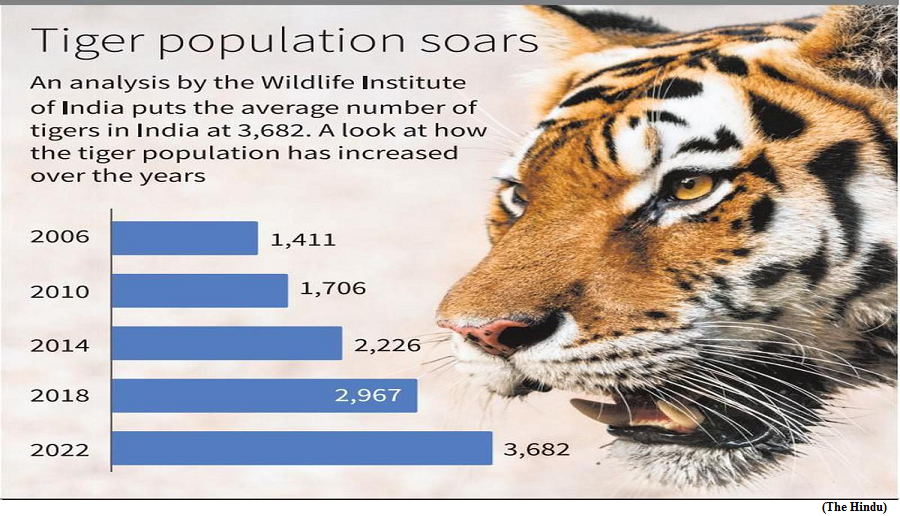India’s tiger population goes up, M.P. has most big cats (GS Paper 3, Environment)

Why in news?
- India’s tiger population increased to 3,682 in 2022, up from 2,967 in 2018, show an estimate released recently.
Details:
- This is an upward revision from April, when a minimum of 3,167 animals were estimated by the Wildlife Institute of India (WII), which coordinates the quadrennial tiger census.
- This also indicates growth over the past decade, there were 2,226 tigers reported in 2014, up from 1,706 in 2010.
Key Highlights:
- In 2022, the highest number of tigers, 785, were reported to be in Madhya Pradesh, followed by Karnataka (563), Uttarakhand (560), and Maharashtra (444). Nearly a quarter of the tigers were reportedly outside protected areas.
- India’s tigers are largely concentrated in 53 dedicated tiger reserves spread across 75,796 square km, spanning about 2.3% of India’s total land area.
- The reserves with the most number of tigers were the Corbett National Park in Uttarakhand, which reported 260 animals, followed by Bandipur (150), and Nagarhole (141), both in Karnataka.
Concerns:
- Central India, the Shivalik Hills, and the Gangetic plains witnessed increases in tiger population, particularly in the States of Madhya Pradesh, Uttarakhand, and Maharashtra. Certain regions, such as the Western Ghats, experienced localised declines, needing targeted monitoring and conservation efforts.
- Some States, including Mizoram, Nagaland, Jharkhand, Goa, Chhattisgarh, and Arunachal Pradesh, have reported “disquieting trends” with smaller tiger populations.
- Approximately 35% of the tiger reserves urgently required enhanced protection measures, habitat restoration, ungulate (deer, chital, blackbuck) augmentation, and subsequent tiger reintroduction.
Tiger population:
- The estimated number of 3,682 is an average figure for a population that likely ranges between 3,167 and 3,925. Tiger numbers are estimated based on the number of unique tigers captured on camera, plus an estimate of animals that may not have been photographed.
- It is quite likely that future exercises may not see dramatic increases in tiger population. Since 2014, India’s tiger numbers have been increasing at 5% to 6% each year.
Threat of dengue fever escalates globally
(GS Paper 2, Health)
Why in news?
- The recent surge in dengue cases globally, including in new regions has been alarming and poses significant global health challenges. The WHO forecasts the possibility of record-level cases in 2023 due to global warming favouring disease-transmitting mosquitoes.

About Dengue fever:
- Dengue fever, caused by the dengue virus (DENV), is a highly prevalent infectious disease estimated to be infecting over 400 million people each year as per the WHO.
- DENV is an RNA virus of the Flaviviridae family with four serotypes (DENV-1 to 4). Infection with one serotype provides lifelong immunity to that type, but subsequent infections with different serotypes can lead to severe, life-threatening forms of the disease.
- There is no specific antiviral treatment for dengue, so prevention relies on controlling mosquito populations and raising public awareness.
Outbreaks in 2023:
- Since the beginning of 2023, several regions in America have witnessed significant dengue outbreaks, reporting over two million cases till July, with Brazil, Peru, and Bolivia having recorded the highest number of cases this year.
- Changing climatic conditions in Europe, such as increased heat waves, floods, and prolonged hot summers, have created favorable environments for dengue-causing mosquito species.
Cases in India:
- Dengue cases have soared in India, mostly due to heavy rains and inadequate control measures, which create the ideal breeding environment for mosquitoes.
- States like Kerala, Odisha, Assam, Tamil Nadu, Maharashtra, West Bengal, and Karnataka are reporting large numbers of dengue cases. The recent surge in dengue cases worldwide including India demands immediate attention and action.
Vaccine:
- Recently, Takeda released the first vaccine for the disease, which has been approved in a few countries.
- The vaccine has modest efficacy in preventing severe disease but still has much ground to cover in terms of preventing infection, providing uniform protection against all serotypes, and ensuring long-term immunity.
Way Forward:
- Continued research and collaboration, including genomic surveillance of the virus, are essential to understanding the evolution and adaptation of the virus, developing effective strategies to combat dengue and other mosquito-borne diseases and safeguarding global health and well-being.



